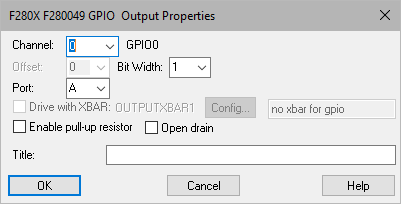
Target Category: Delfino, F280x, F281X, Generic MCU, Linux Raspberry Pi, Piccolo
Target Sub-Category: GPIO
Description: The GPIO Output block outputs digital data. Use GPIO Qualification to set up qualification time intervals for GPIO pins.

Bit Width: Specifies the number of contiguous bits to read in.
Channel: Indicates the channel number. Click here for Raspberry Pi pin mapping.
Drive with XBAR: When activated, the GPIO output is taken directly from OUTPUTXBAR, which you can configure to comparator inputs, GPIO inputs, ADC events, eCAP, and sigma delta comparators. Note that:
•This parameter is available only on newer F280x devices.
•Only certain GPIO outputs (channels) are associated with the OUTPUTXBAR.
To configure the OUTPUT XBAR signal source, click Config. An XBAR MUX dialog appears. Verify that the XBAR register matches the one in the GPIO dialog. You can then select one source signal from the 128 possible inputs. If you select an INPUT XBAR, click OK to return to the GPIO dialog and select the input GPIO from the dropdown to the right of the Cofig button. For more information, see Texas Instruments SPRU712 document.
Enable pull-up resistor: Enables the pull-up resistor on the output pin to 3.3 V. This parameter is available only for devices that support it.
Offset: Specifies the offset into the digital port register.
Open Drain: Allows for communication with external chip protocols. This parameter is available only for devices that support it.
Port: Specifies the digital register. For Raspberry Pi, two ports are available for Raspberry Pi 1A+ and 1B+. For all other Raspberry Pi devices, only one port is available. Click here for Raspberry Pi pin mapping.
Title: Indicates the channel title.